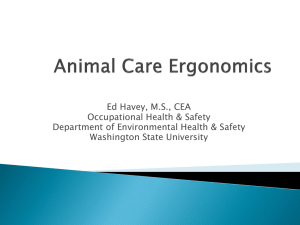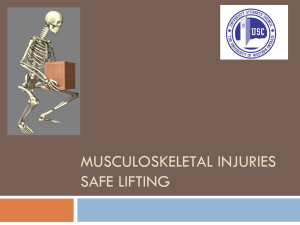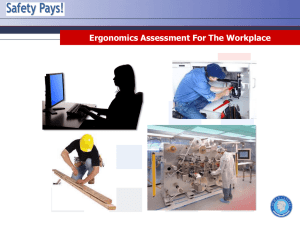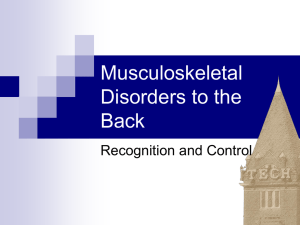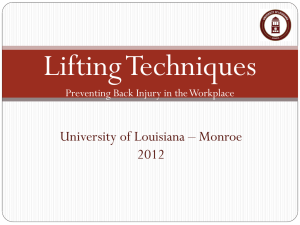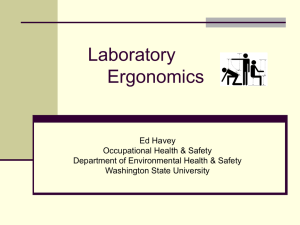ERGONOMI
advertisement
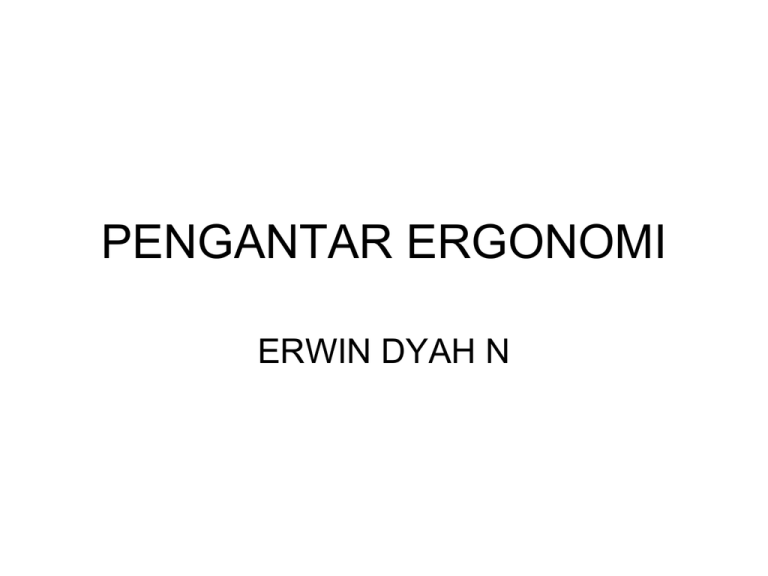
PENGANTAR ERGONOMI ERWIN DYAH N ASAL KATA • ERGOS = KERJA • NOMOS = PERATURAN KERJA, ATURAN, KEBIASAAN KERJA Fakta • Tahun 1993 > 50% klaim kompensasi di Washington State Fund akibat WMSDs ( sprains, strains, nerve compression, and joint inflammation) Biaya langsung dan tak langsung WMSDs • Biaya langsung (pengobatan, absen) > $100 juta • Biaya tak langsung : – investigation time, – decreased production, – training and hiring replacement workers. Sulit dihitung Diperkirakan 2-5 kali biaya langsung Tujuan Program Ergonomi • • • • • prevent injuries manage injuries if they occur save company money, increase worker comfort and safety, decrease injuries & workers' compensation claims and, • increase productivity(quantity &quality) • Increase worker’s morale Bukti Manfaat Ergonomi • In a shop where aircraft interiors are installed, engineering controls and work practice changes increased productivity 10-15 percent, which translated into a benefit of more than $200,000. • Changes made to a work process at a wire installation shop reduced stressful body posture and lowered the assembly time from eight to six and a half hours. Komponen progran ergonomi • Identifying musculoskeletal symptoms and their associated risk factors. • Making changes to jobs to eliminate the risk factors. • Preventing injuries and keeping those that occur from becoming disabling. • Training employees on all of the above. 4 elements of an ergonomics program • • • • Worksite analysis Hazard preventio n and control Medical management Training and education Worksite analysis • a safety and health review that identifies jobs and workstations that may contain musculoskeletal hazards, the risk factors that pose the hazards, and the causes of the risk factors. Hazard prevention and control: • eliminating or minimizing the hazards identified in the worksite analysis by changing the jobs, workstations, tools or environment to fit the worker. Medical management: • the effective use of available health-care resources to prevent or manage workrelated musculoskeletal disorders. Training and education • a method to give both workers and managers an understanding of the potential risk of injuries, their causes, symptoms, prevention and treatment. ERGONOMICS TEAM MEMBERS Small business: • workers/union representatives • managers/supervisors • maintenance or facilities staff • safety and health personnel • purchasing personnel ERGONOMICS TEAM MEMBERS • • • • • • Large business: engineers human resources personnel health care providers ergonomist all listed under small business ERGONOMICS TEAM MEMBERS • Di Indonesia >> dikerjakan oleh K3 • Di perusahaan yg > kecil 1 orang yg menjalankan program • Ex: supervisor tg jwb dlm pembelian adanya ergonomic awareness membantu perkakas/alat kerja yang ergonomis Ergonomi • Pada dasarnya bukanlah suatu disiplin ilmu • > merupakan teknik gabungan beberapa disiplin ilmu untuk memecahkan masalah yang timbul akibat pekerjaan dan lingkungan kerja. PENGERTIAN 1. Penerapan ilmu biologi manusia dalam hubungannya dengan ilmu teknik untuk memperoleh hasil optimal dalam pengaturan manusia dan pekerjaannya dengan keuntungan berupa efisiensi dan kesejahteraan (ILO) 2. Studi ilmiah ttg pekerj. manusia (the scientific study of human work) Fokus Perhatian Ergonomi kapabilitas fisik dan mental keterbatasan pekerja saat berinteraksi dg perkakas & alat kerja metode kerja pekerjaan lingkungan kerja. Tujuan Ergonomi • Mengurangi WMSDs dengan menyesuaikan pekerjaan dengan pekerja, bukan sebaliknya (agar pekerja menyesuaikan terhadap pekeraannya). Bidang Ilmu Yang Mendasari • Lihat skema WMSDs? Work-related Musculo Skeletal Disorders Injuries and risk factors • What are Work-related Musculo Skeletal Disorders (WMSDs)? • Common types and symptoms of injury • Causes and prevention of injury What are Work-related Musculo Skeletal Disorders (WMSDs)? • Also known as: – – – – – – – Cumulative Trauma Disorders (CTDs) Repetitive Strain Injuries (RSIs) Overuse injuries Work Related Upper Limb Disorders (WRULDs) Musculo Skeletal Injuries (MSIs) Musculo Skeletal Disorders (MSDs) Soft tissue injuries • Usually develop gradually, but sometimes can appear suddenly • Can be serious, if not taken care of early What are some of the symptoms of WMSDs? • • • • Discomfort Pain Numbness Tingling • • • • Burning Swelling Change in color Tightness, loss of flexibility What causes WMSDs? Risk Factors – Awkward Postures – High Hand Force – Repetitive Motions – Repeated Impacts – Heavy, Frequent, or Awkward Lifting – Moderate to High Hand-Arm Vibration Risk Factors Risk of injury depends upon: – Duration (how long) – Frequency (how often) – Intensity (how much) – Combinations of risk factors Risk Factors Duration – usually need hours of exposure before risk factors become a concern – Can be all at one time or cumulative over the day Risk factors for WMSDs Awkward postures Neutral postures Head level Shoulders relaxed Elbows at sides Wrists straight Low back supported Feet supported Standing neutral posture Seated neutral posture Hands over head or elbows above shoulders For more than 2 hours per day Neck bent more than 30° For more than 2 hours per day Back bent more than 30° For more than 2 hours per day Squatting For more than 2 hours per day Kneeling For more than 2 hours per day Wrists bent Reducing awkward postures • Change workstation heights & display heights • Tilt or rotate the work • Use platforms • Bring items within easy reach • Pause to stretch Reducing awkward postures Case Study Risk Factors for WMSDs High hand force High hand force A power grip can be 5 times stronger than a pinch grip = Gripping with the whole hand 10 lbs. of weight or force for more than 2 hours per day Pinching with the fingertips 2 lbs. of weight or 4 lbs. of force for more than 2 hours per day Other factors Your grip strength decreases when you: • Bend your wrists • Pick up slippery items • Wear poorly fitting gloves • Have cold hands Avoid pinch grips • Pick objects up from the bottom using whole hand • Attach handles or use lift tools • Build up handles on small tools to reduce grip force Reduce power grip force • Pick up smaller loads • Use power tools instead of hand tools • Keep tools in good working order • Use lighter tools or tool balancers • Use two hands • Keep your wrists straight Avoid holding onto objects for long periods • Use clamps to hold onto work • Place items on carts rather than carrying them • Put down a tool when not actually using it Use tool balancers Case Study Tool use example Working with bent wrists decreases grip strength Use tools that let you keep your wrist straight Risk factors for WMSDs Highly repetitive motions Highly repetitive motion For more than 2 hours per day Reducing repetition • Arrange work to avoid unnecessary motions • Let power tools and machinery do the work • Spread repetitive work out during the day • Take stretch pauses • Rotate task with co-workers if possible • Change hands or motions frequently Reducing repetitive motions Case Study Intensive keying For more than 4 hours per day Reducing intensive keying • Spread keyboard work throughout the day • Use macros for common functions • Take stretch pauses • Improve your posture and move around as much as possible Risk factors for WMSDs Repeated impacts Repeated impacts Using the hand or knee as a hammer more than 10 times per hour, more than 2 hours per day Avoiding repeated impacts • Use tools instead of your hand or knee Risk factors for WMSDs Heavy, frequent or awkward lifting Heavy lifting • Lifting 75 lbs. once per day • Lifting 55 lbs. more than 10 times per day Reducing heavy lifting • Take smaller loads at one time • Use mechanical assistance handtrucks, carts, hoists, conveyors • Get help from a coworker Frequent lifting • Lifting more than 10 lbs., more than twice per minute, for more than 2 hours per day Reducing frequent lifting • Use mechanical assistance • Slide objects instead of lifting them • Rotate lifting tasks with co-workers if possible Awkward lifting • Lifting more than 25 lbs. above the shoulders, below the knees or at arms’ length more than 25 times per day Reducing awkward lifts • Store items where you won’t have to bend or reach to lift them • Use rolling stairs to get items down from high shelves Safe lifting technique Risk factors for WMSDs Moderate to high hand–arm vibration Vibration Moderate levels of vibration for 2 hours per day High levels of vibration for 30 minutes per day Reducing vibration • Use low vibration tools if available • Maintain tools • Use tool wraps or anti-vibration gloves • Keep hands warm If you have identify a caution zone, what next ? • Analyze it by using table 2 (do it thoroughly and systematically) – Pay attention on physical demands of the job (body position, force, repetition) – The lay out of the work area (reaches, working heights – The load lifting and handling requirements of the job (object size and shape) • If the physical risk factor exceed table 2 A HAZARD IS PRESENT TAKE ACTION !! – Changes to workstations and tools – Reducing the size and weights of loads handled – Process redesign to eliminate unnecessary steps or introduce task variety – Job rotation If the action cannot reduce hazards • While looking for alternatives to solve the problems permanently – PPE – team lifting – training of work technique How to see the check list • Go to acrobat reader doc.(hazard assessment check list-table 2) page 7-14 What you can do: • Recognize and report symptoms early • Get involved in ergonomics Symptom recognition and reporting • Report symptoms if: – Pain is persistent, severe or worsening – Pain radiates – Symptoms include numbness or tingling – Symptoms keep you from sleeping at night Why is it important to report symptoms early? • Chronic injuries sometimes lead to disability, even surgery • Early treatment more successful Getting involved • • • • • Look at jobs and help identify problems Come up with solutions Work with solutions Take part in training Take responsibility for changing the way you do your job • Help to make sure efforts are successful Six key points to remember 1 Ergonomics can help you on your job 2 Employers have to implement ergonomics if caution zone jobs are present 3 Risk factors can be reduced and WMSDs prevented 4 You can help your company put ergonomics changes into place 5 WMSDs can happen in jobs with risk factors 6 Reporting symptoms early is important Purposes • To Identify specific work place hazards that can cause or aggravate work-related MSIs, and than to reduce the workers exposure • It does not and cannot eliminate all MSIs among affected workers • It’s only reduce incidence / severity of MSIs caused in whole or in part of the risk factors listed in in the hazard assessment checklist • Non work-exposures and risk factors inherent individual worker are not addressed • Use of this recommendation is voluntary Is this a caution zone job? • A caution zone job is a job where worker’s typical work activities meet one or more of the physical risk factors and level listed in table 1 • Typical work activities are those that are regular and forseeable part of the job , > 1 day/week , > 1 week/year • Caution zone job all have sufficient degree of risk -> need some precautionary steps be taken (ergonomic awareness training and hazard assessment)-but they do not necessarily have risks great enough to require corrective action • Caution zone may not be hazardous The duration list in table 1 (see acrobat reader doc , page 3) • Two hours – refer to the total amount of time workers exposed to the risk factors, not how long they spend performing the work activity that includes the risk factor What action that employer should take • If there are no physical risk factor exceeding the level list in table 1 NO ACTIONS ARE REQUIRED • If ≥ 1 physical risk factors exceed the level list in table 1CAUTION ZONE JOB ergonomic awareness training to provide workers with a basic level of understanding knowledge The training for workers should include: • How to use their work station, including how to adjust its equipment and furnishings • How to use or select tools appropriate to the work they are performing • The safe work practices they are expected to follow; and • Information describing the signs, symptoms and methods of preventing MSIs When should a hazard performance be performed • When work process or operation changes • When a new work process is introduced • Prior to the design and installation and a new workstation • Affected worker should be involved in hazard assessment Ergonomics Rule: Major features Do you have “caution zone” jobs? No Not covered No requirements No hazards present Annual review No additional requirements Yes Two requirements: •Awareness education •Evaluate “caution zone jobs” for hazards Hazards present Reduce exposure below the hazard level or to the degree feasible Annual review
